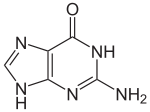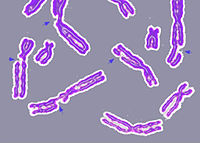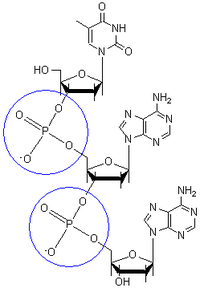Chimica organica/RNA: differenze tra le versioni
Nessun oggetto della modifica |
Nessun oggetto della modifica |
||
| Riga 3: | Riga 3: | ||
== Le basi azotate == |
== Le basi azotate == |
||
Con il termine di basi azotate in biochimica ci si riferisce a |
Con il termine di basi azotate in biochimica ci si riferisce a |
||
{| {{Tabella_Ch_Org}} |
|||
{| class="wikitable" |
|||
! colspan=2|Basi azotate puriniche |
! colspan=2|Basi azotate puriniche |
||
! colspan=3|Basi azotate pirimidiniche |
! colspan=3|Basi azotate pirimidiniche |
||
|- |
|- |
||
|[[Image:Adenin.svg| |
|[[Image:Adenin.svg|120px| Adenina]] |
||
|[[Image:Guanin.svg|150px| Guanina]] |
|[[Image:Guanin.svg|150px| Guanina]] |
||
|[[Image:Cytosin.svg| |
|[[Image:Cytosin.svg|120px| Citosina]] |
||
|[[Image:Thymin.svg|150px| Timina]] |
|[[Image:Thymin.svg|150px| Timina]] |
||
|[[Image:Uracil.svg| |
|[[Image:Uracil.svg|120px| Uracile]] |
||
|- |
|- |
||
|colspan=5|[[Image:Adenosin.svg|150px| Adenosina]] |
|colspan=5|[[Image:Adenosin.svg|150px| Adenosina]] |
||
Versione delle 15:37, 18 ago 2008
Le basi azotate
Con il termine di basi azotate in biochimica ci si riferisce a
| Basi azotate puriniche | Basi azotate pirimidiniche | |||
|---|---|---|---|---|

|

|

|

|

|

| ||||
DNA e RNA
| Queste sono solo alcune immagini, che presto verranno corredate da testo | ||
|---|---|---|

|
 |

|

|
File:AUHoogsteen.png | |

A phosphodiester bond is a group of strong covalent bonds between the phosphorus atom in a phosphate group and two other molecules over two ester bonds. Phosphodiester bonds are central to all life on Earth, as they make up the backbone of the strands of DNA. In DNA and RNA, the phosphodiester bond is the linkage between the 3' carbon atom and the 5' Carbon of the sugar ribose.
The phosphate groups in the phosphodiester bond are very negatively-charged. Because the phosphate groups have a pKa near 0, they are negatively-charged at pH 7. This repulsion forces the phosphates to take opposite sides of the DNA strands and is neutralized by proteins (histones), metal ions, and polyamines.
In order for the phosphodiester bond to be formed and the nucleotides to be joined, the tri-phosphate or di-phosphate forms of the nucleotide building blocks are broken apart to give off energy required to drive the enzyme-catalyzed reaction. When a single phosphate or two phosphates known as pyrophosphates break away and catalyze the reaction, the phosphodiester bond is formed.
Hydrolysis of Phosphodiester bonds can be catalyzed by the action of phosphodiesterases which play an important role in repairing DNA sequences.
In biological systems, the phosphodiester bond between two ribonucleotides can be broken by alkaline hydrolysis because of the free 2' hydroxyl group.
